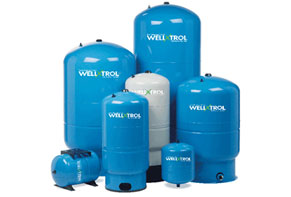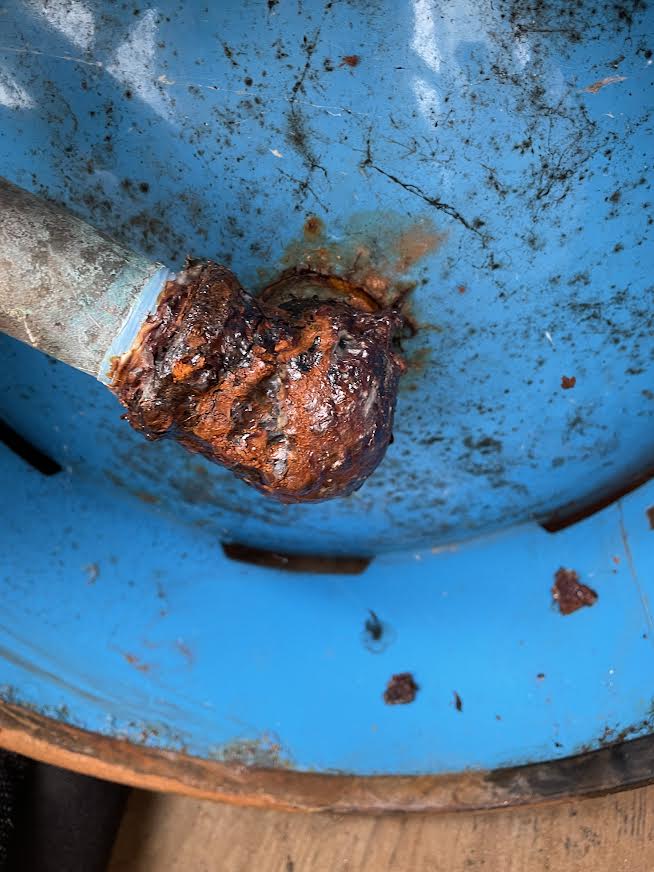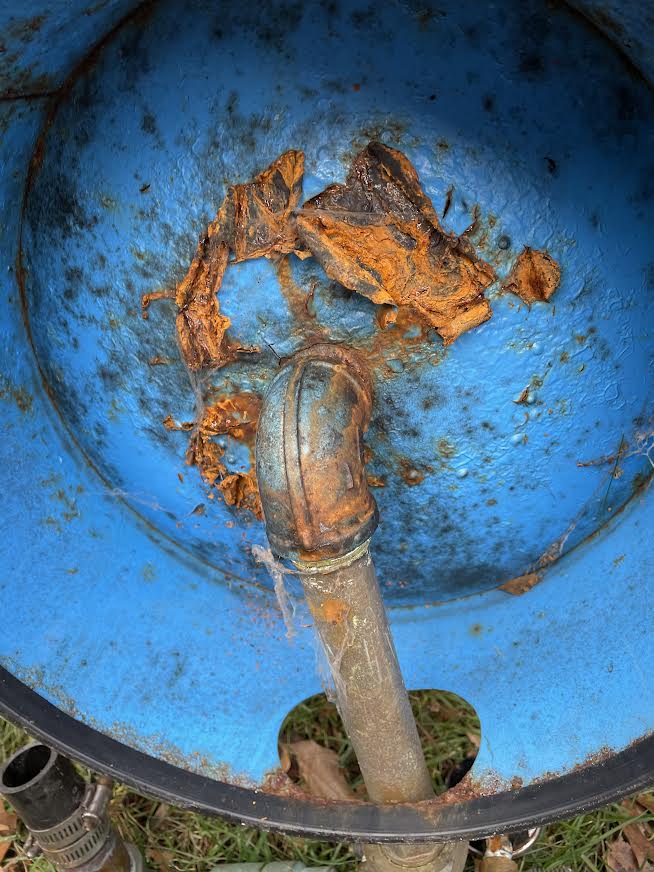
Each water system is unique and has different needs. Please contact our office at 603-868-3212 with specific questions about your water delivery and filtration system.
If you live at a property with a well, you’ve probably noticed the blue metallic tank in your basement, crawl space or utility closet and thought to yourself “Hmmm…I wonder what that is?” Well, my friend, that tank may very well be your pressure tank.
In this blog post we will go over:
- What a pressure tank is
- What role it plays in your homes water system
- Basic maintenance
- When to replace it

What is a Pressure tank?
A pressure tank can come in all different shapes and sizes. They can be small or large, made of steel or fiberglass, and can be blue, gray, any color really. The important thing is that the tank is able to hold water under pressure. Within this tank is a rubber bladder, Where the water is stored. Above this bladder is a space for compressed air. This compressed air generally has a pressure reading either 28 psi or 38 psi depending on your systems design. These tanks are intended to hold onto this air pressure and keep it at a constant.
What role does a pressure tank play in your home?
If you live at a property with a well then you most likely have a water pumping system that utilizes a pressure tank. Below is a sketch of a well with a submersible well pump.

In normal circumstances, your home’s plumbing is pressurized because the air in the pressure tank is pressing against the bladder filled with water and this force is transferred to all of the water fixtures in your home. As you open a faucet, water is instantly sent to your sink because of the pressure being applied to the bladder. As you use water the pressure in the tank begins to drop.
If your tank was left to its own devices, this applied force will eventually empty the tank completely and you would be left without any water. This is where the pressure switch comes in.
A pressure switch is an electrical component that sends power to your pump when needed. It does this by utilizing a small diaphragm and spring system that senses pressure.
Once the water pressure drops to the cut in pressure (Commonly, 30 psi – 40 psi), the switch will engage and cause the contacts in the switch to close, completing the connection from the electricity in your home to the well pump. This engagement is what allows for your well pump to kick on and send water to the pressure tank.
At this point in the cycle, the contacts will stay open until the pressure switch reaches its shut off pressure (Commonly, 50 psi – 60 psi). If you are using a large amount of water, your well pump may not be able to achieve shut off pressure while you are using water. In this instance you will be at the mercy of how much water your well and your pump can deliver. If you are using a small amount of water, your pump may be able to achieve that shut off pressure because the amount of water the system is able to deliver exceeds the amount of water being used at that given time.
Once you stop using water, the system will deliver water to the pressure tank until it reaches the cut off pressure (Commonly, 50 psi – 60 psi) and the system will remain at that pressure until water is used again.
This cyclical pattern of drawing the water in the pressure tank down to the cut on pressure and filling it up to the cut off pressure is what’s happening as you use water throughout the day.
This technology is not very sophisticated but it gets the job done. If you’d like to learn about our systems that utilize more technology, and are more robust, take a look at our blog post about Constant Pressure Systems!
Basic Maintenance:
There isn’t a whole lot when it comes to maintenance for a pressure tank. It is more of a practice of monitoring. It is important to monitor the condition of the tank because a failed tank can lead to a dead pump or flooding in a basement.
Air pressure- To see how much air is in the tank, the first thing you need to do is drain down the system. If you don’t do this then you will just be reading the overall system pressure. At the top of the tank there will be a cap covering a nipple. This is a testing port where you can use an air gauge or tire gauge to see the air pressure in the tank.
If you take the cover off of your pressure switch (Danger! Live electricity within the switch) you’ll be able to see the cut in and cut out pressure labeled inside of the switch. Typically most systems are on a 30/50 or 40/60 cycle system. The air pressure in the pressure tank should be a few psi below the cut in pressure meaning a 30/50 cycle system should have around 28 psi of air pressure and a 40/60 cycle system should have around 38 psi of air pressure.
If the air pressure is below the desired amount, then the system will have to deliver more water to the pressure tank in order to compensate for the drop in air. This then causes the bladder to expand potentially leading to premature failure. An example of this failure is when the bladder ruptures and water is able to get above the bladder resulting in what we call a waterlogged tank. This causes the system to be unable to regulate the pressure and the system will begin to short cycle.
Visual inspection- make sure that your pressure tank is not showing any obvious signs of degradation. If you have a stainless steel tank you may start to notice areas of rust after a period of time. Eventually the rust can eat away at the steel and will cause an opening resulting in a blow out. Below are some pictures of tanks that have failed due to rust.



When to replace:
A failed pressure tank is the quickest way to kill a well pump and a tank that lets go of water can easily flood a basement. This is why it is so important for homeowners to know when to replace the tank.
There are 5 reasons to replace a pressure tank
- Showing signs of rusting that may compromise the integrity of the tank
- Tank is between 10-15 years old
- Significant loss of air pressure
- Improperly sized tank
- Waterlogged tank
Pressure tanks play a vital role in a home’s water delivery and water treatment system. By better understanding what a pressure tank is and how it plays a role in your home’s water system will help you to prevent problems from happening and address problems mwht your system.
Each water system and family has different needs to please feel free to call us at 603-868-3212 with any questions about pressure tanks, water supply, or water treatment.


